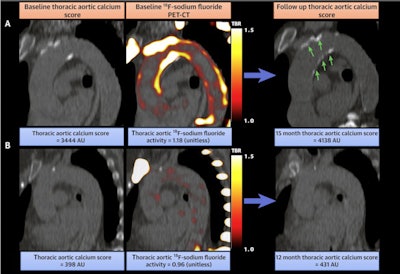
PET/CT scans can show plaque development in atherosclerosis patients and may help predict which patients are at higher risk of stroke, according to a study published February 16 in JACC: Cardiovascular Imaging.
British Heart Foundation (BHF) researchers and an international group of colleagues explored for the first time whether F-18 sodium fluoride (NaF) PET/CT could identify plaque in aortic arteries and whether the findings were linked to their risk of stroke. Over six years, they found patients with higher F-18 NaF activity in plaque were at a significantly higher risk.
"F-18 sodium fluoride activity is correlated with thoracic aortic atherosclerotic disease progression and a 10-fold increased risk of future ischemic stroke," wrote Dr. Marc Dweck, PhD, a researcher at BHF's Center for Cardiovascular Science at the University of Edinburgh in Scotland.
Stroke remains a leading cause of long-term disability and death across the world. CT scans are an effective way for identifying patients at risk of stroke based on the volume of calcified plaque the scans reveal in a patient's thoracic aorta. Yet CT calcium scores are thought to represent a later and more stable stage of the disease process, according to the authors.
In previous research, the group showed that F-18 NaF-PET/CT scans can reveal earlier stages of atherosclerosis, yet whether the approach has the potential to predict downstream clinical outcomes is unknown, the authors wrote.
In this study, Dweck and colleagues analyzed imaging in 461 patients diagnosed with stable coronary artery disease or aortic stenosis who underwent F-18 NaF-PET/CT scans (Biograph mCT, Siemens Healthineers) of the thoracic aorta in one of four previous BHF trials. They determined the progression of atherosclerosis based on changes in aortic and coronary CT calcium volumes, while outcomes were determined by cases of stroke.
Next, the researchers looked at the prognostic utility of F-18 NaF activity for predicting stroke compared to clinical risk scores and CT calcium scores.
After more than a year, baseline thoracic aortic F-18 NaF activity correlated with the progression of thoracic aortic calcium volume in 140 patients (r = 0.31; p = 0.00016), the researchers found. Out of 461 patients, 23 (5%) experienced an ischemic stroke after approximately six years of follow-up.
 Relationship between thoracic aortic F-18 sodium fluoride activity and progression of thoracic aortic calcium score (Agatston units). (A) Example case in which intense F-18 sodium fluoride activity on PET/CT precedes areas of macrocalcification on CT. (B) Example case of low F-18 sodium fluoride activity and minimal progression of macrocalcification on computed tomography. Image courtesy of JACC: Cardiovascular Imaging.
Relationship between thoracic aortic F-18 sodium fluoride activity and progression of thoracic aortic calcium score (Agatston units). (A) Example case in which intense F-18 sodium fluoride activity on PET/CT precedes areas of macrocalcification on CT. (B) Example case of low F-18 sodium fluoride activity and minimal progression of macrocalcification on computed tomography. Image courtesy of JACC: Cardiovascular Imaging.High thoracic aortic F-18 NaF activity was strongly associated with ischemic stroke (hazard ratio [HR]: 10.3 [3.1 to 34.8]; p = 0.00017), the authors found. In addition, a multivariable Cox regression analysis that included imaging and clinical risk factors showed that thoracic aortic F-18 NaF activity was the only variable associated with ischemic stroke (HR: 8.19 [2.33 to 28.7], p = 0.0010), the authors reported.
"Arterial F-18 sodium fluoride activity identifies localized areas of atherosclerotic disease activity that are directly linked to disease progression and downstream regional clinical atherothrombotic events," the group wrote.
The researchers noted that they've shown in earlier work that higher coronary F-18 NaF activity on PET/CT is associated with faster coronary atherosclerosis progression and also may serve as a powerful predictor of heart attacks.
From a clinical perspective, this indicates that a single thoracic F-18 NaF PET/CT scan could potentially provide simultaneous information on both thoracic aortic and coronary F-18 NaF activity. That could help identify individuals diagnosed with atherosclerosis who are at high risk of both stroke and myocardial infarction and who might benefit from intensive or advanced preventative therapies, according to the authors.
"Larger studies in prospective cohorts are required to assess this further and are currently in progress," Dweck and colleagues concluded.





















